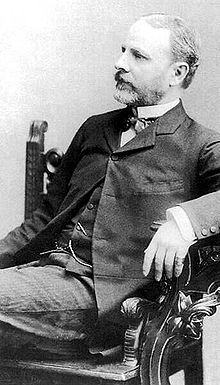Khuen Hedervary
|
Count Károly Khuen-Héderváry de Hédervár |
|
|---|---|
 |
|
| Prime Minister of the Kingdom of Hungary | |
|
In office 27 June – 3 November 1903 |
|
| Monarch | Francis Joseph I |
| Preceded by | Kálmán Széll |
| Succeeded by | István Tisza |
|
In office 17 January 1910 – 22 April 1912 |
|
| Monarch | Francis Joseph I |
| Preceded by | Sándor Wekerle |
| Succeeded by | László Lukács |
| Ban of Croatia-Slavonia | |
|
In office 4 December 1883 – 27 June 1903 |
|
| Preceded by | Hermann Ramberg |
| Succeeded by | Teodor Pejačević |
| Personal details | |
| Born |
Károly Khuen de Belás 23 May 1849 Gräfenberg, Austrian Silesia, Austrian Empire (today Lázně Jeseník, Czech Republic) |
| Died | 16 February 1918 (aged 68) Budapest, Hungary |
| Nationality | Hungarian |
| Spouse(s) | Countess Margit Teleki (born Margit Teleki de Szék) |
| Children | Sándor Károly |
Count Károly Khuen-Héderváry de Hédervár, born as Károly Khuen de Belás (Croatian: Dragutin Khuen-Héderváry, 23 May 1849, Bad Gräfenberg (Czech: Jeseník), Austrian Silesia – 16 February 1918, Budapest), was a Hungarian politician; Ban of the Kingdom of Croatia-Slavonia in the late nineteenth century. He succeeded the temporary reign of Ban Hermann Ramberg in 1883. Khuen's reign was marked by a strong magyarization. After a series of riots broke out against him in 1903, Khuen was relieved of his duty and appointed prime minister of Hungary.
Károly Khuen de Belás was the oldest son of seven siblings born to Hungarian magnate Antal Khuen de Belás (1817–1886) and his wife, Baroness Angelika Izdenczi de Monostor et Komlós (1823–1894).
His three siblings died when they were children.
According to the last Count Viczay de Loós et Hédervár, Héder Viczay's will, and the Court's supreme decision (dated Vienna, on 5 December 1874), Károly was granted the bearing Khuen-Héderváry name and title of Count. He changed his title from Belási to Hédervári and his new coat of arms was compiled by the two families' coat of arms. His maternal grandmother was Karolina Viczay, Héder's aunt. In addition Héder's brother, Károly Viczay (1802–1867) married to Mária Khuen (1811–1848), Károly Khuen-Héderváry's aunt.
Khuen-Héderváry married Countess Margit Teleki de Szék on 6 September 1880. They had two children: Sándor (1881–1946) and Károly the Younger (1888–1960).
During his time as ban, the Hungarian language came into official use and Hungarian symbols were brought alongside the national symbols of the Croats. Khuen was forced to deal with many protests, including one during the 1895 visit of King Franz Joseph. At the opening of the Croatian National Theatre in Zagreb which the King was attending, a group of students burned the Hungarian flag beneath the statue of Ban Jelačić.
...
Wikipedia
